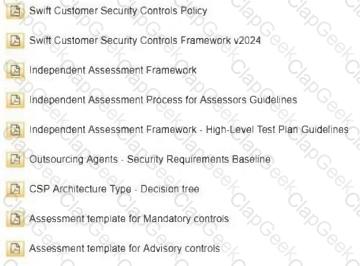SWIFT (Society for Worldwide Interbank Financial Telecommunication) is a global cooperative that provides a secure messaging network primarily for financial transactions. Its services are designed for entities involved in the financial ecosystem, and access is restricted to members or participants who meet SWIFT’s membership criteria. Let’s evaluate each option:
•Option A: Financial institutions, such as banks and securities broker-dealers
This is correct. SWIFT’s core users are financial institutions, including banks, broker-dealers, and other entities regulated under financial authorities. These institutions are direct members of SWIFT or connect through correspondent banking relationships. The SWIFT Customer Security Programme (CSP) and CSCF are tailored to secure the messaging environment for these entities, with controls like "1.1 SWIFT Environment Protection" designed to safeguard their operations. Membership requires adherence to SWIFT’s security standards, and these institutions use SWIFTNet for payments, securities, trade, and treasury services.
•Option B: Individuals who use online banking for international transfers
This is incorrect. Individuals, including those using online banking for international transfers, do not connect directly to SWIFT. Instead, they rely on their banks or financial service providers, which act as intermediaries using SWIFT’s network. SWIFT is a business-to-business (B2B) network, not a consumer-facing platform. The CSCF does not address individual users; its focus is on institutional security controls, such as those protecting the SWIFT secure zone.
•Option C: Market infrastructures that provide financial institutions with centralized transaction processing
This is correct. Market infrastructures, such as clearinghouses, central securities depositories (CSDs), and payment systems (e.g., TARGET2 or CHAPS), are eligible to connect to SWIFT. These entities facilitate centralized transaction processing for financial institutions and are part of the broader financial ecosystem. SWIFT documentation recognizes their role, and they are subject to the same security requirements under the CSP. For example, CSCF Control "1.2 Physical Security" applies to these infrastructures when they host SWIFT-related components.
•Option D: Corporates that work with multiple banking partners
This is correct. Corporates, especially large multinational corporations with complex financial operations, can connect to SWIFT through SWIFT’s corporate connectivity options, such as Alliance Lite2 or SWIFT for Corporates. These services allow corporates to send and receive payment instructions directly via SWIFTNet, bypassing some intermediary steps with banks. This capability is outlined in SWIFT’s corporate access documentation, and such entities must comply with CSP security controls when integrating with the SWIFT network. The CSCF extends to these participants, ensuring their environments are secure (e.g., Control "6.1 Security Awareness").
Summary of Correct Answers:
Financial institutions (A), market infrastructures (C), and corporates with multiple banking partners (D) can connect to SWIFT, either as direct members or through specific connectivity options. Individuals (B) do not have direct access.
References to SWIFT Customer Security Programme Documents:
•SWIFT Customer Security Controls Framework (CSCF) v2024: Applies to all SWIFT users, including financial institutions, market infrastructures, and corporates, with security controls tailored to their environments (Controls 1.1, 6.1).
•SWIFT Membership Guidelines: Outlines eligibility for financial institutions, market infrastructures, and corporates, excluding individuals.
•SWIFT for Corporates Documentation: Details corporate connectivity options like Alliance Lite2.









